3. BASIL

Tomatoes and basil make for a great combination in spaghetti sauces, and in your garden, the two plants may help each other grow. According to many amateur and professional gardeners, basil serves as a natural bug repellent that drives off unwanted insects that might otherwise eat the herb—or munch on your tomato fruits; some speculate is that planting the two near each other somehow gives the tomatoes a much better flavor. Garden-raised basil needs plenty of sunlight and should be arranged accordingly. Plant the seeds at least 12 inches apart six weeks before the last frost comes along. Water them lightly whenever the soil feels dry and you’ll have a healthy plant that will keep giving you delicious leaves all summer long. Mangia!
4. MINT

Another hardy herb, mint is ridiculously easy to grow. In fact, mint does so well outdoors that the biggest challenge associated with it is keeping the plant from taking over your whole garden. But before we get into that, let’s talk logistics. Mint needs damp soil with good drainage, and it tends to do best when kept in an area that receives a moderate amount of shade during the day.
Under favorable conditions, the herb’s specialized stems—known as “runners”—shoot out in all directions. Left unchecked, the runners will devour every inch of available real estate, sometimes conquering entire lawns in the process. For this reason, many people grow their outdoor mints in clay pots from which the roots can’t escape. But if you want to put yours in a multi-species garden, plant it on the inside of a long, tubular container with an open bottom and thick walls. An 18-inch metal stove pipe buried vertically with its uppermost inch poking out above the surface would be perfect. Patio edges and driveways can also be effective root barriers.
